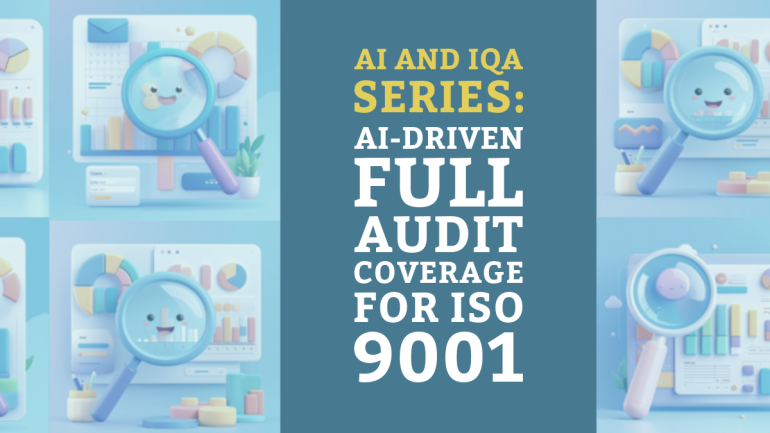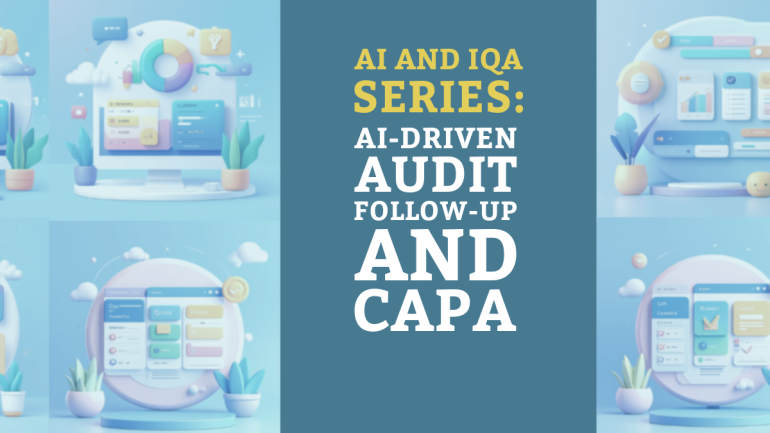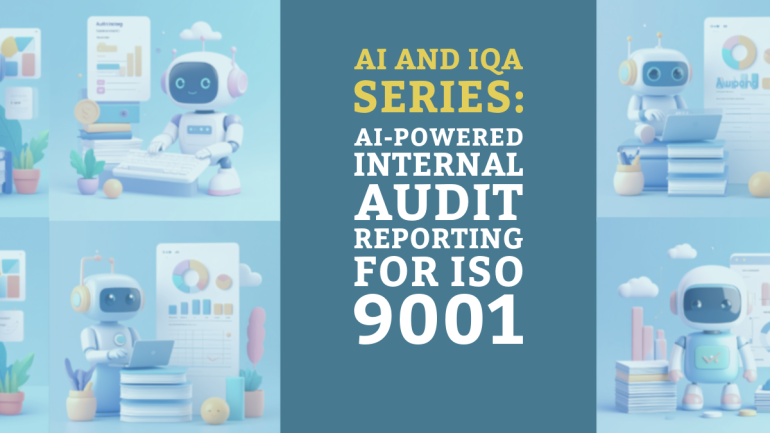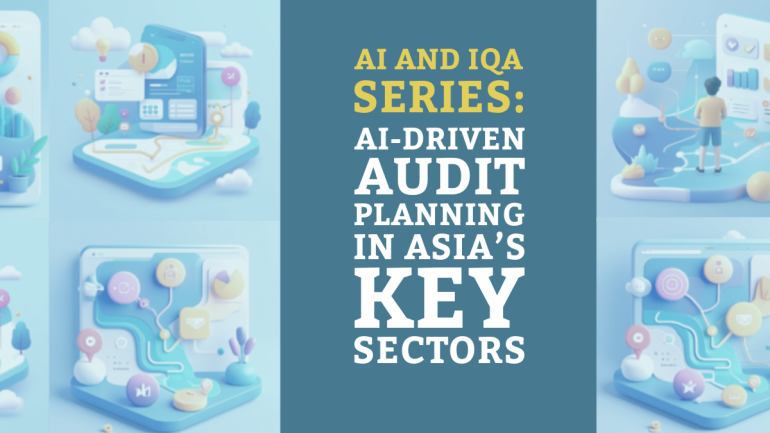Table of Contents
TL;DR: Comprehensive Audit Testing with AI
- AI is shifting ISO 9001 internal audits in Asia from sampling-based testing to full-data analysis, enabling continuous, real-time auditing aligned with ISO 19011 principles.
- Sectors like manufacturing, healthcare, finance, and education are deploying AI to review 100% of transactions, patient records, and quality processes, dramatically increasing assurance depth.
- Real-world examples (e.g., Toyota, Singapore hospitals, Malaysian banks, Philippine universities) show AI delivering measurable benefits such as defect reduction, fraud detection, and audit cycle acceleration.
- Human auditors remain essential to interpret AI findings, validate conclusions, and ensure audits remain evidence-based, risk-focused, and strategically aligned.
Internal audits for ISO 9001 quality management systems have traditionally relied on sampling – checking a subset of processes or records – due to time and resource limits. Today, AI is enabling organizations to analyze 100% of their data and transactions, shifting audits from selective testing to full coverage. For example, instead of sampling 5% of transactions, auditors can use AI analytics to test 100% of transactions for anomalies , dramatically increasing assurance. Public-sector auditors in Singapore report that AI tools have uncovered issues traditional sampling might miss, illustrating how data analytics can augment audit effectiveness. Aligned with ISO 19011 guidelines (which emphasize evidence-based, risk-focused auditing), AI allows continuous monitoring of all quality records and controls, flagging outliers in real time. The result is more proactive compliance testing – finding non-conformities or risks as they occur rather than long after the fact. Asian organizations have been at the forefront of this shift, with high AI adoption and government support. In fact, Asia-Pacific leads in deploying advanced AI for business value, and Singapore ranks first in AI readiness among APAC countries. Below we explore real-world 2023–2024 case studies from Asia – particularly Singapore, Japan, South Korea, and Malaysia – across industries (manufacturing, healthcare, finance, education) where AI is replacing or minimizing traditional sampling via automation, full-data analysis, continuous auditing, and anomaly detection.
Manufacturing: Continuous Quality Audits in Japan and Asia
Manufacturers are embracing AI to achieve zero-defect quality and continuous improvement in their ISO 9001 systems. A recent MIT Technology Review survey found 64% of manufacturers are exploring AI to enhance product quality, moving beyond sample-based QC checks. Japan’s manufacturing sector offers a striking example: Toyota integrated AI into its internal quality audits across global factories , having algorithms analyze all production data to spot deviations in quality metrics and trigger proactive corrective measures. This AI-driven approach ensures compliance with ISO 9001 standards on a global scale, far beyond what periodic manual sampling could achieve.
Similarly, companies across Asia are deploying machine vision and anomaly detection on the factory floor to inspect 100% of products or process data in real-time, catching defects or process non-conformities immediately. In practice, an AI system can continuously monitor equipment and process outputs 24/7 and flag any out-of-tolerance condition or unusual pattern. Auditors then investigate these flags, rather than conducting after-the-fact sample inspections. This full-data coverage greatly increases confidence that quality issues won’t slip through.
As one audit expert noted, AI lets auditors test every item or transaction and “uncover hidden truths” in the data that human sampling might miss . The result in manufacturing is higher product quality and faster corrective action – a competitive advantage in precision-driven industries. These Industry 4.0 initiatives in Japan, South Korea, and Singapore’s high-tech manufacturing are minimizing human error and variability, as AI systems apply audit rules uniformly and tirelessly. The adoption is accelerating: surveys show over 79% of industrial firms see AI as critical to their future , and many have implemented real-time quality risk analysis. By 2024, AI-powered quality audit tools have helped some manufacturers reduce defect rates and compliance costs significantly (in some cases double-digit percentage improvements), validating the move away from limited sampling toward continuous assurance in production.
Healthcare: Full-Coverage Compliance Monitoring in Hospitals
The healthcare sector, with its stringent quality and safety standards, is also turning to AI to achieve full audit coverage. Hospitals and healthcare organizations certified to ISO 9001 (or similar standards) must audit everything from patient record-keeping to medication management. AI now makes it feasible to review all such records and transactions for compliance issues – something infeasible by manual sampling. A notable case is the Mayo Clinic in the U.S., which employed an AI system for billing compliance audits, analyzing every medical billing record for accuracy and policy adherence. The AI flagged billing errors and potential compliance issues in real time, providing instant feedback to auditors. This showcases how AI can ensure financial integrity in healthcare by combing through 100% of claims rather than a sample. In Asia, healthcare providers are beginning to pilot similar approaches. For example, Singapore’s hospital audit teams have started assessing AI systems for regulatory compliance and patient data privacy – essentially auditing the AI that monitors their operations.
More directly, health systems are exploring AI for continuous monitoring of clinical processes: an AI might scan every prescription and treatment entry against protocols to detect any deviation or anomaly (such as a medication dosage outside the allowed range), alerting staff immediately. This kind of continuous clinical audit can catch errors that a periodic chart review might overlook, enhancing patient safety. In countries like Japan and South Korea, where aging populations and universal healthcare put pressure on quality control, AI-driven audit tools are being tested to monitor things like 100% of pharmacy dispenses or sterilization cycles for compliance. One study in the Philippines demonstrated an AI-enabled QMS that could even match internal audit findings to the exact clauses of ISO 9001 with over 82% accuracy, automating much of the audit review process. By 2024, the AI model in that study could predict 70% of audit findings in advance – meaning the system learned from years of data to foresee where non-conformities would occur. This kind of predictive auditing is especially valuable in healthcare, where preventing a single lapse (e.g. an expired medication or missed equipment calibration) can be life-saving. Overall, across Asia’s hospitals and clinics, AI is beginning to augment internal audit and quality teams, allowing them to continuously watch over all operations – from hygiene checks to patient consent forms – and focus on investigating the exceptions that AI flags. This ensures no aspect of patient care quality falls through the cracks due to random sampling.
Finance: Continuous Transaction Auditing and Fraud Detection
The financial sector in Asia has aggressively adopted AI for continuous auditing and risk management, given the huge volumes of transactions and the high stakes of compliance (e.g. anti-fraud, anti-money-laundering, and internal controls). Internal audit teams in banks are using AI to test every transaction for anomalies or control deviations, replacing the old model of sampling a subset of accounts. In Singapore and Hong Kong, global banks like HSBC have implemented AI-driven tools for enhanced risk assessment in anti-money-laundering (AML) audits – the AI analyzes transactional patterns and flags any irregularities that might indicate fraud or money laundering. HSBC’s approach, deployed across Asia-Pacific, has strengthened risk management and regulatory compliance by catching suspicious activities in real time.
In practice, such an AI might cross-check every fund transfer against known fraud patterns or sanction lists instantaneously. Likewise, Citibank rolled out AI in its internal audits across multiple countries to monitor transactions and compliance in dynamic fashion. The AI identified risk patterns (for example, unusual trading activities or policy violations) and provided auditors with live insights, demonstrating adaptability to different jurisdictions’ requirements. These tools enable continuous auditing of financial operations, far beyond the quarterly sample checks of the past. Crucially, regulators in Asia encourage this shift. In 2024, Malaysia’s central bank (Bank Negara) launched a National Fraud Portal leveraging AI to detect suspicious transactions across the entire financial system via predictive analysis. This portal, involving all major banks, continuously scans domestic transactions for red flags (such as abnormal transfer patterns), rather than relying on reports of a few incidents. It exemplifies how AI can provide full-coverage oversight: the system automatically traces and freezes fraudulent funds across multiple institutions in seconds, something impossible with manual methods.
Such efforts have already yielded results – over 12,000 investigations were opened and RM72 million frozen by mid-2024 through automated detection. In addition, internal auditors in banks are using AI to re-perform calculations or reconciliations on 100% of data – for instance, recalculating interest on every loan in a portfolio via RPA/AI to verify the bank’s systems are correct. This provides much higher confidence in financial reporting accuracy. With financial services being an AI frontrunner (79% of firms say AI is critical to their future), Asian institutions are also seeing tangible benefits: nearly 48% of risk managers report revenue gains from AI (e.g. better fraud catch), and 43% report cost reductions from AI-driven efficiency. These stats underscore that continuous, AI-enabled auditing is not just theoretically better – it directly contributes to the bottom line by preventing losses and reducing manual compliance costs. From Singapore’s digital banks to Japan’s insurance firms, AI-based continuous auditing is fast becoming the norm, elevating assurance levels well beyond what traditional sampling audits could ever provide.
Education: AI-Assisted ISO 9001 Audits in Universities
Even the education sector in Asia is leveraging AI to enhance internal audits for ISO 9001 and accreditation compliance, aiming for full coverage of academic and administrative processes. A 2023 study of Philippine higher education institutions developed an AI-enabled QMS that could automatically cross-reference every audit finding with the relevant ISO 9001:2015 clause and even predict likely non-conformances. By training on five years of past audit reports and accreditation reviews, the AI achieved over 82% accuracy in classifying findings and successfully predicted 70% of issues that auditors eventually reported. This suggests that the system effectively “audited” a vast corpus of internal data (policies, reports, survey results) and learned to identify where the university might be out of compliance – for example, spotting if any department failed to meet a required procedure.
Such a tool means an internal audit team could let the AI scan all available evidence (documents, records, feedback) across the entire institution and highlight potential gaps, instead of the auditors manually sampling a few documents per faculty. The result is a more comprehensive audit that ensures no campus unit or criterion is overlooked. In a practical scenario, an AI might parse thousands of course feedback forms or exam outcomes to ensure quality objectives are met everywhere, surfacing anomalies (like a course with consistently poor outcomes or missing documentation) that warrant attention. Beyond this research project, universities in Malaysia and Singapore are also exploring AI for continuous monitoring of compliance with academic quality standards. For instance, an AI could continuously check that every faculty’s curriculum files and assessment results are up-to-date and aligned with the approved standards – essentially a nonstop audit ensuring readiness for external accreditation visits.
Conclusion: Toward Continuous Assurance Across All Sectors
Across Asia in 2023–2024, these examples demonstrate a clear trajectory: AI is moving internal audits and compliance testing from periodic sampling to continuous full coverage. Whether it’s a factory in Japan using anomaly detection to inspect every product, a hospital in Singapore employing AI to review all patient billing or safety checks, a bank in Malaysia monitoring every transaction for fraud, or a university in the Philippines analyzing all audit data for ISO 9001 compliance – the common theme is that automation and intelligent analytics now comb through complete data sets.
This yields unparalleled assurance depth: AI doesn’t get fatigued or biased, and it can find subtle patterns humans miss. Live statistics from recent deployments are compelling: for example, Singapore’s Auditor-General found data analytics pilots helped catch irregularities invisible to traditional methods, and companies report saving hundreds of hours per audit by using AI while expanding audit scope. Importantly, these AI tools align with ISO 19011’s emphasis on evidence and risk-based auditing – by processing all evidence, they focus human auditors on the riskiest outliers. Auditors in Asia note that this synergy lets them spend more time on analysis and improvements rather than rote inspection. Of course, AI doesn’t replace the auditor’s judgment or the need for human oversight; rather it elevates the auditor’s role into one of interpreting AI findings and pursuing strategic improvements.
FAQs
- How does AI enable full audit coverage compared to traditional sampling?
AI allows auditors to analyze 100% of data—transactions, records, quality outputs—instead of sampling small subsets, dramatically increasing audit assurance and catching anomalies that traditional methods might miss. - Which industries in Asia are leading in AI-driven full audit coverage?
Manufacturing (e.g., Toyota), finance (e.g., HSBC, Citibank), healthcare (e.g., Singapore hospitals), and education (e.g., Philippine universities) are at the forefront of implementing AI for full audit coverage. - How does AI full coverage auditing align with ISO 9001 and ISO 19011?
By enabling continuous, risk-based monitoring of all quality-related activities and maintaining comprehensive, evidence-backed audit trails, AI enhances compliance with ISO 9001 requirements and ISO 19011 auditing guidelines. - What are the measurable benefits of using AI for full audit coverage?
Organizations report outcomes like 90% reductions in manual audit steps, double-digit improvements in defect rates, faster fraud detection, and hundreds of audit hours saved, along with broader risk visibility. - Does AI replace auditors in a full coverage audit?
No. AI augments, but does not replace, auditors. While AI handles data crunching and anomaly detection, human auditors must still validate findings, investigate root causes, and exercise professional judgment in line with ISO 19011.





